‘I smell it, taste it, feel its heaviness’: Life in Delhi’s dust | Environment
Listen to the audio version of this story here.
It was February in Manali, Himachal Pradesh, in the western Himalayas. As the winding highway took a turn along the Beas river, our taxi’s clean, just-washed windshield quickly gathered a thick patina of dust.
Dogs chased the car, their limbs like the flapping wings of a bird struggling to move through a dust storm. I scanned the dawn mountainscape for lights, subconsciously looking for even the remotest semblance of city life, and saw more dust. As we rolled up our windows, the dust was already between our teeth, covering our clothes and the book in my hand.
As part of a recent series of major infrastructure projects in the state, a new tunnel was inaugurated by the prime minister in October 2020. As work gets on to construct a six-lane highway connecting this remote town with higher areas in the Himalayas, we watched roadside buildings, shops and small towns all bathed in what looked like months of dust, and pondered the true cost of this development.
Dust is everywhere in north India, like a trail left behind by the development. Marking its territory, it never leaves us alone, even during vacation. On the highway, in our food, in the washrooms; the dust is omnipresent.
At the start of this trip, on a late February night, we boarded the state transport bus from Delhi to Manali. Through the 12-hour road journey, we were constantly assaulted by a miasma of dust combined with vehicle fumes. Wading through a thick haze, our bus driver tried to manoeuvre his way through the slow traffic. That night, unable to stop for dinner or even washroom breaks, I felt more restricted than ever by the dust.
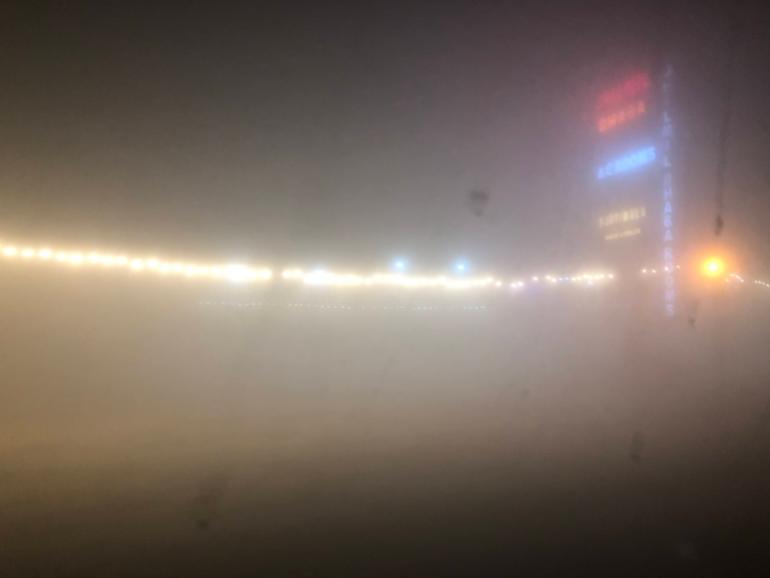 Delhi Shimla highway in February 2021 [Anandi Mishra]
Delhi Shimla highway in February 2021 [Anandi Mishra]I tried to squint and narrow my eyes to see through the haze but kept finding a thick translucent sheet. Unable to even see beyond a couple of metres, those hours felt phantasmagorical. It was nothing like I had ever seen before.
This dust, brought from the edges of peri-urban Delhi, was piled on passing vehicles, gathered around the corners of dhabas (roadside restaurants) and rested atop various parked trucks – almost as if the dust itself was a resource awaiting sale and redistribution.
We had not read anything about this haze in the daily news, so it felt like being caught in a new, unforeseen dimension. Combined with the oppressiveness of our face masks, we felt cast off, even forgotten, by the rest of the world. That night, tightly ensconced in claustrophobia, unable to sleep or even pause to straighten our backs off the bus, I watched the dust take over my life like never before.
‘Dust meant freedom, now it ties us in’
I had never felt this strongly affected by the seemingly “normal” dust pollution that is all-pervasive in north India. But the more I think of it now, the more I realise how perhaps dust was always there, I just chose to not think about it.
In the late 1990s, on family road trips we took in and around the states of Madhya Pradesh, Uttar Pradesh, Delhi and Punjab, dust was a constant companion. The roads in Uttar Pradesh were not well laid out; riddled with potholes, it sent up thick plumes of dust whenever a vehicle passed. Our windows rolled down, the dust would occupy every open surface, covering our hair, faces and teeth. I hardly remember if we even registered it, except for the immediate dirt it left in its wake. Now, the memory of those trips feels tense.
In India and Burma, Aldous Huxley writes, “One breathes in it (India), not air, but dust and hopelessness. The present is unsatisfactory, the future dubious and menacing.”
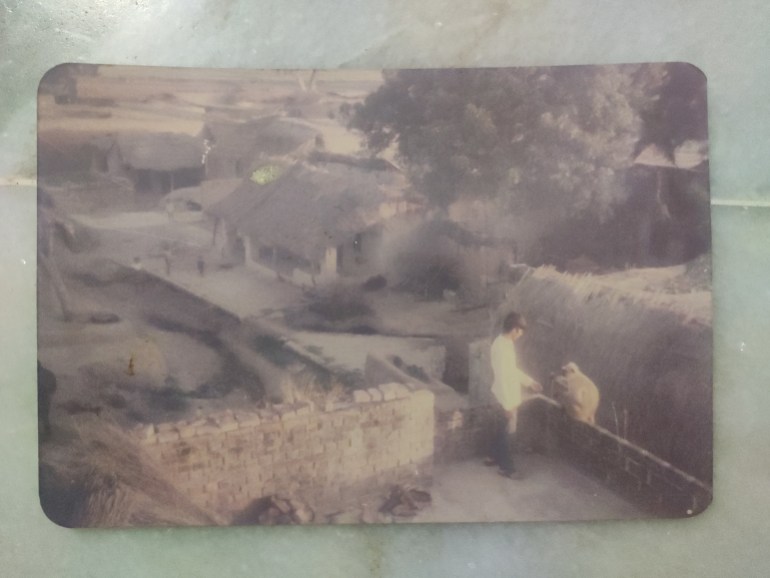 Dust was a part of the writer’s childhood and of her parents’ lives in rural Kanpur [Courtesy of Anandi Mishra]
Dust was a part of the writer’s childhood and of her parents’ lives in rural Kanpur [Courtesy of Anandi Mishra]I was born in Kanpur, about 400km (about 250 miles) away from the capital, where dust was an intrinsic part of our everyday life. Huxley’s sentiments about breathing dust held as true then, in my 90s school days, as they do now.
As toddlers playing outside my father’s house, rolling in the dirt, running, soiling ourselves with it along with other elements of the earth, we were freer than we ever would be. After an evening of play, when my brother and I returned home, our hands, knees, elbows, faces and clothes covered in dirt, an earthy scent covered us.
Dust then meant freedom. My mother while instructing me to study hard and get out of this town would often cite getting away from this dirt as one of the chief objectives.
Now, this dust ties us in.
Thick enough to write in
In 2021, in the midst of a raging pandemic, north India is also experiencing a wave of construction. Living and working in Delhi, it feels like there is more dust accumulating than ever before. Each time I cough, I feel a chill rise, the dread of a disease or a longstanding illness waiting to take over my life.
The skies are almost always a shade of yellow, the grime always between our toes; when I pet stray cats in my neighbourhoods, a nebula of dust leaves their scraggly bodies. I look out the window of my room and see a powdery veil obscuring the view. On most days, the coating is so thick and prevalent, I could write in it using my finger.
 A worker pushes a wheelbarrow at a construction site in Mumbai, India, August 31, 2018 [Reuters/Francis Mascarenhas]
A worker pushes a wheelbarrow at a construction site in Mumbai, India, August 31, 2018 [Reuters/Francis Mascarenhas]It is a variant of this same oppressive dust that forms the concrete skeleton of the expanding country that India is. Dust then becomes a way of understanding the material that is also the making of India. In this way, dust becomes a way of seeing the cities and, by extension, the country.
A method in itself, dust in India is the point from where I try to make sense of the upcoming, burgeoning nature of development. A way to grapple with its constant flux of becoming, unbecoming and re-becoming. In this sense, this dust is more than just a component of the city; rather, it reveals itself as a metaphor for the city itself.
Delhi’s geographical location is also to be blamed for this accumulation of dust, its land-locked nature adding to the woes. The capital city lies to the northeast of the Thar Desert (Rajasthan), to the northwest of the central plains, and to the southwest of the Himalayas. This creates a bowl-like situation, trapping all incoming winds here right before the Himalayas.
‘Maybe dust should be a form of currency?’
Driving through Manali as an urban, middle-class person from the capital, the dust we see casts a spell of doom. But it is not always the case for the locals. Our driver, Sanju, a resident there, boasted about the benefits of construction, remarking proudly that the development has resulted in higher property prices in the area, better connectivity, and a boom in business. Considering the larger economic benefits, the health effects of construction are a minor problem for many.
The current Indian government led by Prime Minister Narendra Modi believes that its limited resources, due to the impact of COVID-19 on the economy, are better spent on infrastructure. Instead of a separate urban employment programme, the government believes this infrastructure push will create employment for locals.
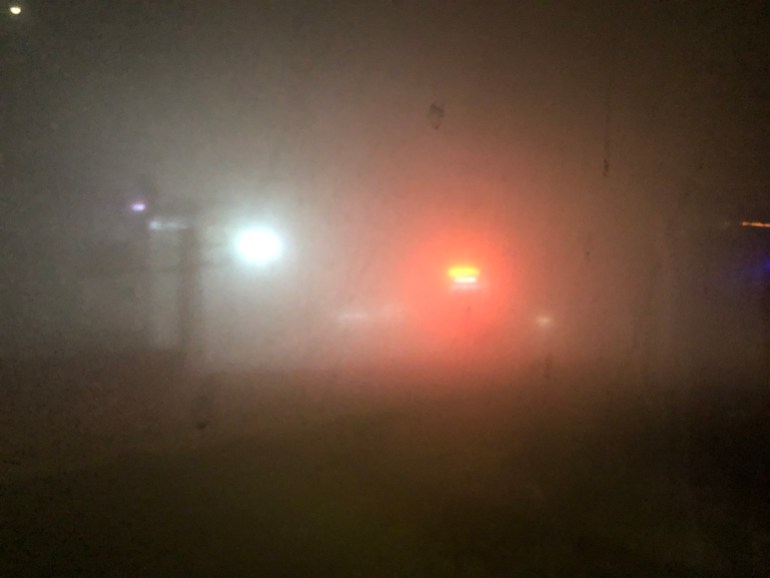 The Delhi-Shimla highway in February 2021 [Anandi Mishra]
The Delhi-Shimla highway in February 2021 [Anandi Mishra]Over the years, the speed of road construction has become a benchmark for India’s infrastructure creation. Now, under Modi, the government has set in place a new integrated infrastructure programme, which involves building roads, railways, waterways and airports. In the process, the government has revived the highway sector, which was reeling under stress and lack of private investment. But there is no mention of the enormous cost the residents of north India have to pay for this.
Dust has morphed into a way of communicating the existence of development in parts of India. Even in the remotest corners, mounds of dust sit, denoting the existence of development somewhere in the vicinity. I joke with friends that dust should be a form of currency, that perhaps this would lead to its control.
‘In Delhi, we live in the future’
On March 30 this year, Delhi experienced strong surface winds that enveloped the city. They brought dust from the neighbouring state of Rajasthan, painting the otherwise blue March skies a deep shade of yellow. By 11am, the capital was shrouded in brown dust, resembling the orange-brown haze Delhi experiences every year around Diwali.
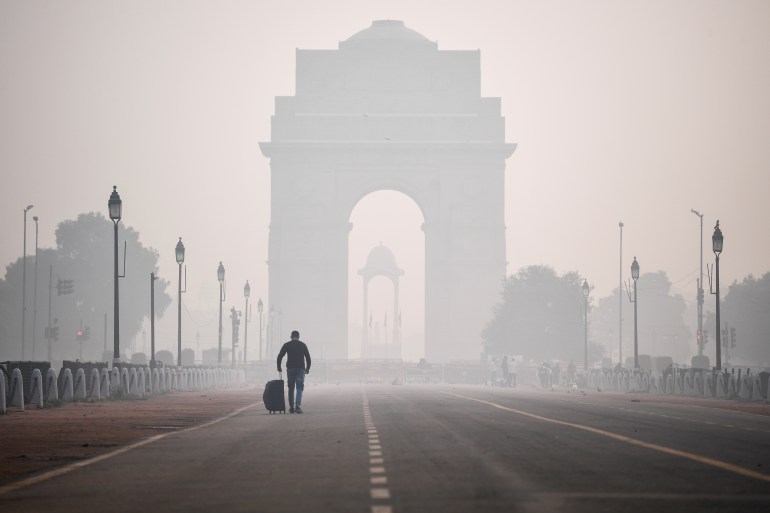 A man walks along Rajpath Street near India Gate amid smoggy conditions a day after Diwali, the Hindu festival of lights, in New Delhi on November 15, 2020 [Sajjad Hussain/AFP]
A man walks along Rajpath Street near India Gate amid smoggy conditions a day after Diwali, the Hindu festival of lights, in New Delhi on November 15, 2020 [Sajjad Hussain/AFP]As I worked and made lunch, I forgot to shut my rooms’ windows. When I came back to the room, my desk, bed, chair and water bottle were all coated in a thick sheet of dust. I quickly finished lunch and started cleaning up. Wiping the layer of it off all corners of my laptop, dusting the bed, fluffing the pillows, and wiping the desk, I was covered in dust, and able to taste it. It felt like an envoy, conveying a sense of impending doom. I texted a friend jokingly, “I think in Delhi, we live in the future.”
The next day the sun was out but the dust remained.
With the arrogance of a seasoned Delhiite, I peeked out from my balcony, seeing a vast rusty cloud looming over the city, convinced that my lungs, already leathered and damaged by the bad air I inhaled during my childhood, could take some more of it. Within seconds, my eyes itched, the chest was aflame, and my throat parched. I let out a ratchety, tubercular cough.
A near-constant drizzle
Stepping out of my flat in south Delhi one cold December morning in 2020, I sensed a strange, acrid smell at first and then felt an ephemeral powdery presence, which I immediately recognised as dust.
In my hometown, the dust from poorly laid roads took over entire neighbourhoods and engulfed whole highways. No one cared about the air quality in Kanpur then. We all carried on with our lives. A near-constant drizzle of dust fell on us as we hung out on the balcony. That December morning in Delhi felt the same.
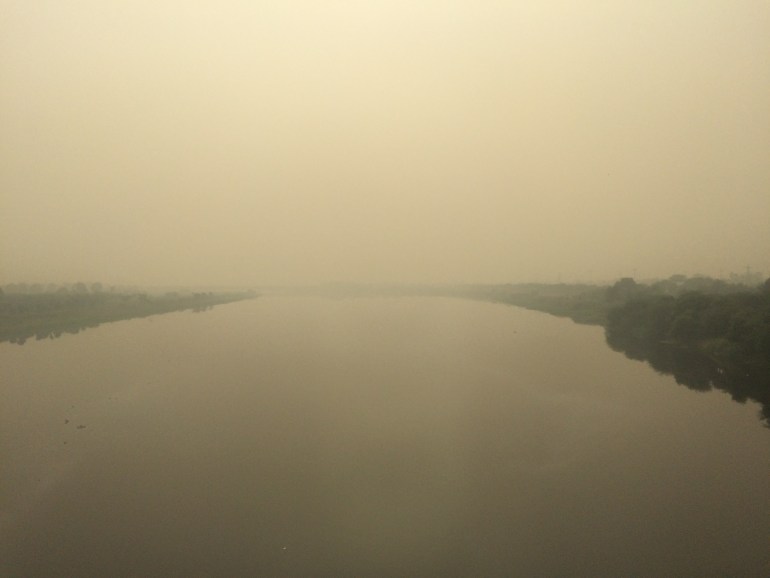 Hazy dust settles over part of Delhi, in October 2016 [Anandi Mishra]
Hazy dust settles over part of Delhi, in October 2016 [Anandi Mishra]Scrolling through the day’s news I saw articles about rising air pollution, empty promises made by the government to address the issue and seasonal apocalyptic photographs of the city. The people in my neighbourhood were unconcerned, carrying on with their days as if it was a trifle that did not need much attention. I, on the other hand, was obsessed with the dread that the smudgy grey sky above conveyed.
Back home, I removed my shoes to discover the several grammes of dust I had brought along. It was everywhere. There was a thin coating of soot on my clothes, inside my hair, on my skin. No matter how much I brushed it away, it did not seem to leave.
In the few minutes that I took to close the door behind me, it had entered and spread on the floor, as if underscoring its presence. But within the next few days I stopped noticing it, and life, as it always does, went on.
Living beneath a veil
Surrounded on all sides by its satellite towns like Noida, Gurugram, Ghaziabad and Faridabad, Delhi has been at the centre of various kinds of ongoing construction work for at least the last few years. These areas are a common site for workers and building projects, and are under a constant blanket of thick smog. Heavy dust cakes windows and clogs throats at all times. The dust comes from two main places: kicked up by cars along Delhi’s vast and growing road network, and various construction sites. Raw materials like brick and concrete required to carry on with construction are a big contributor to this dust too. This results in air that is so foul that doctors have advised children and the elderly to wear masks continuously.
Every winter, as the chill descends, car exhaust combine with the dust, leading to a strange heavy smog that covers the city for weeks. If we’re lucky, a spell of rains can dissipate the shroud of smog for a few days, otherwise, it lasts for long, windless stretches. Now, I realise what I was sensing on my first winter day out in Delhi was a reality to which longtime Delhiites are now accustomed.
In the last four years, this smog has radically reworked my experience of the city. Living beneath this veil of dust, my days and nights constantly surveilled by its presence, has led me to live a limited life. There is a constant looming threat. To live here is to experience an undoing in time, a constant heaviness in the chest, one knot atop another. You create a schedule, it falls apart, you try and create another one, and it scatters further still. There is a danger in exercising, going for a run, even walking.
 The dusty sky over a neighbourhood in Delhi, in December 2013 [Anandi Mishra]
The dusty sky over a neighbourhood in Delhi, in December 2013 [Anandi Mishra]Before the pandemic, because of the dust, I was limited in my interactions with the outdoors. Now, stepping out is even more daunting. To help allay the fears, however momentarily, friends are buying cars to avoid taking public transport, treadmills to avoid running outdoors, and air purifiers to be able to breathe good air at home.
Where I live in Chittaranjan Park, an affluent south Delhi neighbourhood, there are now more construction sites than houses. People are selling their ancestral homes to builders who are throwing up apartment buildings at an unprecedented rate. On a five-minute walk in any direction, I pass more than seven construction sites. Their condition is the same – barely covered piles of rubble spilling out onto the pavement, no fencing to keep the wind from whisking this dust into the streets and enormous mounds of dirt sitting in empty lots.
Grown used to them, people simply choose to look through these sites. Widely disregarded as even a topic of mild concern – unless the air quality index shoots beyond the dreaded 999 mark – this dust is now an extension of life in Delhi. Before the pandemic, we were used to spending approximately 1,500 rupees ($20) to secure sturdy N95 masks for the Diwali season. In my previous job where we shared the building with a Japanese firm, I saw expatriates from ASEAN countries dipping in and out, wearing a surgical mask throughout the year. I noticed them, thinking they knew something I didn’t. When in reality, I shared that knowledge, but I just choose not to acknowledge it.
The normalcy of dust
Dust in Delhi has starkly dictated how I interact with the city in the last four years I lived here. I have seen it enter and seldom leave. I have seen how it exacerbates the air pollution woes in the city during the festive Diwali season, but we chalk it up to stubble-burning in neighbouring areas and move on.
Dust, for me, has become a way of understanding the material rhythms that undergird the concrete production of the city. Through it I look at how Delhi has become a temporary stopping site for dust – a kind of transition space where it transforms from nature to concrete materiality, making and then unmaking the place in a way.
However bad it is, the air I breathe on my walks in Delhi is nevertheless a pale version of what my parents must have endured in Kanpur. Being a former industrial town, the city went into decline after the mills there went bust. In the early- and mid-1990s, I remember my grandmother used to burn coal in the veranda of our house to warm us in winter.
For most people, the pall in the air is but another manifestation of the prevalent mood of neglect by the government, of constant apathy and abandonment. From childhood, I internalised the idea that we all breathe the same air. But around me now, I see something else: clean air is something, increasingly, that you can buy.
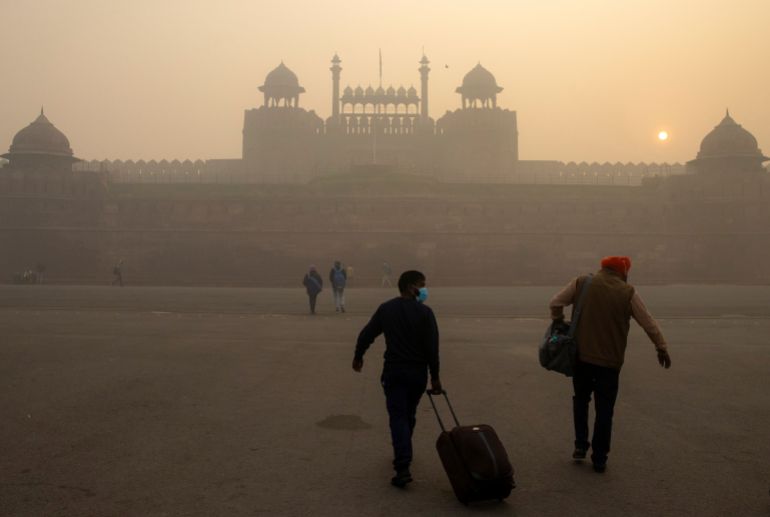 People arrive at the Red Fort on a smoggy morning in Delhi, India, November 10, 2020 [Reuters/Danish Siddiqui]
People arrive at the Red Fort on a smoggy morning in Delhi, India, November 10, 2020 [Reuters/Danish Siddiqui]Dust is a tangible aspect of living now; an intrinsic part of the grey landscape, looming like a dull adjective. We factor it in while planning short vacations around Delhi, mindful of allergies, carrying medicines, masks.
The air we breathe was something to be taken for granted, but in Delhi, I can smell it, taste it, feel its heaviness on my palms. It has forced itself into my life, tagging along everywhere with me inadvertently.
During the dust storm on March 30, even as I shut the doors and windows tight, I could almost hear it insinuate its way in through the small gap under the doors and between the spaces in the window. It laid itself down as if tired after all the travel, splaying over everything in a fine sooty layer. Sensing its presence around me I realised how this dust is now a part of my being. As much as I wipe it away, it never really leaves.
The dust has now taken the form of paranoia, under whose fear I clean, scrub, dust and wipe every corner of the house once and then over and over again.
There is a pathetic sense of normalcy that prevails around dust in India, the acceptance that it is not going anywhere. I try to fight this immutable part of life, to push back against this feeling, in the daily struggle to remember that we were all here before the dust. Or were we?
